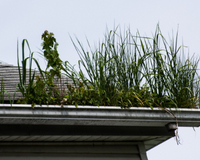Cleaning and maintaining gutters and downspouts is essential to the roofing systems. If you don't, it will lead to water damage and costly repairs in the future. It helps to maintain your house and protect your home from problems caused by excess moisture.
Gutters are made of metal or plastic and can be found on the roof's edge. They meet at a downspout, which leads the water away from the house and into the ground.
Depending upon your home, gutters and downspouts can be troughs that carry rainwater to a drainpipe or may have no channel. To allow easy debris removal, the gutter should run the roof length, preferably in a zigzag pattern.
Gutters and downspouts are cleaned using a telescoping pole with a brush on one end or a small vacuum attached to a long pole. You can also use a good old-fashioned broom to clean out the gutters.
You can find downspouts at the corner of the house where two walls meet. They can also be either on the side of the house or directly below an eavestrough. The downspout is connected to the gutter by adjustable connectors that you need to reposition when installing new gutters.
Downspouts are also cleaned similarly to gutters, with either a telescoping pole or long-handled brush.
Your gutters and downspouts will rust if they aren't maintained at least twice annually. Failing to clean them will also result in clogged gutters, eventually leading to leaks in your home. Leaks, as you know, are cumbersome to repair, not to mention costly.
The Connection Between Roofs, Gutters, and Downspouts
Gutters and downspouts are essential to the function of roofing systems. They prevent water from collecting on the roof, leading to a costly problem. Even a tiny leak can cause substantial damage over time if not appropriately addressed.
Houses with many trees or vines around them require more maintenance as leaves, twigs, and acorns that fall from them over time enter the gutters causing clogs.
Clean gutters thoroughly to avoid clogging and plant growth. This prevents putting too much weight on roofing systems.
To ensure a proper rainwater runoff, gutters should consistently slope downward toward downspouts.
If this is not the case, water might pool in some areas and seep back underneath your shingles. This traps the water, eventually leading to an overflow of water underneath your shingles and into your home's roof or interior walls.

Remove the leaves and other debris accumulated in your gutters or downspouts.
Using a hose, spray out the inside of your gutters. If you don't have a hose available, you can use an old broomstick to push the debris out by bracing it against the gutter and pushing it through.
If you need to clean out the excess debris, use a shovel with a long handle. It's important not to go up onto your roof because if you fall off the ladder or step, the imbalance will cause injury or death.
After removing most of the leaves, collect and bag the debris for disposal.
If leaves are stuck inside your gutters, scrape them with a long-handled paint scraper. If you don't have one, grind up some ice cubes and then use that to remove the leaves.
For this step, you can also use an old broom or a long-handled leaf rake.
If mould and mildew are in your gutters, you can use bleach or a bleach alternative, like vinegar, to remove them. Mix the solution in a bucket onto the mouldy areas with a sponge. Allow the mixture to sit for five to ten minutes, then rinse it.
Once the insides of your gutters are clean, inspect them for holes or cracks. Make sure they are thoroughly dry before you begin working with them again if you do find any. Once they are dry, use a thin sealant layer on the cracks or holes.
If there are cracks or holes in your gutters, you should apply a sealant layer on the gutter's exterior and downspouts to prevent water damage. The sealant will allow water drainage through your gutters while protecting your house from leaks or moisture damage.
Once your gutters are clean, it's essential to inspect them for any potential problems that might cause roof leakage or other damage. If you spot any issues, be sure to fix them immediately.
Check with your local roofing systems contractor if you need new gutters or downspouts. You want to ensure that the contractor has experience installing these gutters and recommend whether you need new ones. It is also essential to work with a professional because hiring an inexperienced worker could potentially cause more damage to your roof or home.
You should also check with your contractor about professional cleaning services for your gutters. This will ensure that the exterior of your gutters is clean and clear of any debris, which will eventually clog them up again.
To maintain your gutters, you should have them cleaned out at least once a year. You can check with your contractor for specific advice about how often to clean the exterior of your gutters based on precipitation and other local factors.
Regularly maintaining your gutters will help prevent damage from occurring to the interior and exterior of your home.
Gutters and downspouts help to channel rainwater away from your home; you should clean them soon after the leaves begin to fall in autumn. If you fail to do so, the gutters and downspouts will become caked with mud and dirt, while their screens become clogged with debris.
By having your gutters and downspouts cleaned twice a year, you can avoid overflowing gutters, unsanitary conditions, roof leaks, and damage to your home. Gutters and downspouts help to channel rainwater away from your home.
Roofing Johnson City has been providing high-quality roofing systems services to the area for over ten years. We would be happy to help you maintain your property's exterior.
We can also provide a free estimate on any new materials or installations you may need! Call today for more information about our services.
